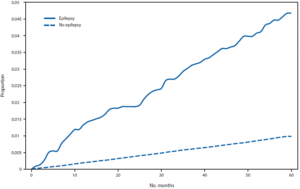
Unadjusted cumulative mortality estimates of Iraq and Afghanistan war veterans during the 60-month follow-up period after initial provider visit, by epilepsy status — Veterans Health Administration, United States, 2011–2015
HOUSTON – The COVID-19 pandemic has presented new challenges for VA healthcare delivery, although access to care has always been difficult for veterans who either live in remote areas or have conditions that require specialist care. That is especially significant for conditions such as epilepsy, where face-to-face evaluations can be important in verifying diagnoses and monitoring disease progression.
That’s why a study led by researchers from the Houston VAMC and Baylor College of Medicine has proven to be so important. The team sought to assessed the predictive diagnostic value of home videos of spells with or without additional limited demographic data in US veterans referred for evaluation of epilepsy; video-EEG (v-EEG) diagnosis was used as a gold standard.
“Veterans, in particular, stand to benefit from improved diagnostic tools given higher rates of PNES and limited accessibility to care,” they wrote in an article published in the journal Epilepsy & Behavior.1
The prospective, blinded diagnostic accuracy study in adults was conducted from December 2015 to June 2019. Patients with a definitive diagnosis of epileptic seizures (ES), psychogenic nonepileptic seizures (PNES), or physiologic nonepileptic events (PhysNEE) from v-EEG monitoring were asked to submit home videos. Participating were 50 patients – 30 men and 20 women, average age 47.7; of these, 14 had ES, 33 had PNES, and three had PhysNEE diagnosed by v-EEG.
Four board-certified epilepsy specialists blinded to the original diagnosis then presented a diagnostic impression based upon the home video review alone and video plus limited demographic data.
Researchers determined that diagnostic accuracy by video alone was 88.0%, with a sensitivity of 83.9% and specificity of 89.6%. They found, however, that providing raters with basic patient demographic information in addition to the home videos did not significantly improve diagnostic accuracy when comparing to reviewing the videos alone. The study also reported that inter-rater agreement between four raters based on video was moderate with both videos alone (kappa = 0.59) and video plus limited demographic data (kappa = 0.60).
“This study demonstrated that home videos of paroxysmal events could be an important tool in reliably diagnosing ES vs. PNES in veterans referred for evaluation of epilepsy when interpreted by experts,” the authors concluded. “A moderate inter-rater reliability was observed in this study.”
In effect, researchers documented that home videos are 88% accurate in differentiating epilepsy from nonepileptic events and were more successful at ruling out epilepsy (i.e., higher specificity) than non-epileptic seizures (NES). They also reported that psychiatric and military history weren’t that useful in differentiating ES from NES in veterans.
Noting that home video diagnosis can improve access and enable faster diagnosis in veterans, who often must travel to see a specialist, the authors posited that veterans at rural locations may particularly benefit from home video diagnosis.
- Karakas C, Modiano Y, Van Ness PC, Gavvala JR, Pacheco V, Fadipe M, Thanaviratananich S, Alobaidy AM, Purohit A, Fussner S, Chen DK, Haneef Z. Home video prediction of epileptic vs. nonepileptic seizures in US veterans. Epilepsy Behav. 2021 Feb 18;117:107811. doi: 10.1016/j.yebeh.2021.107811. Epub ahead of print. PMID: 33611097.
- Pugh MJ, Van Cott AC, Amuan M, et al. Epilepsy Among Iraq and Afghanistan War Veterans — United States, 2002–2015. MMWR Morb Mortal Wkly Rep 2016;65:1224–1227. DOI: http://dx.doi.org/10.15585/mmwr.mm6544a5

